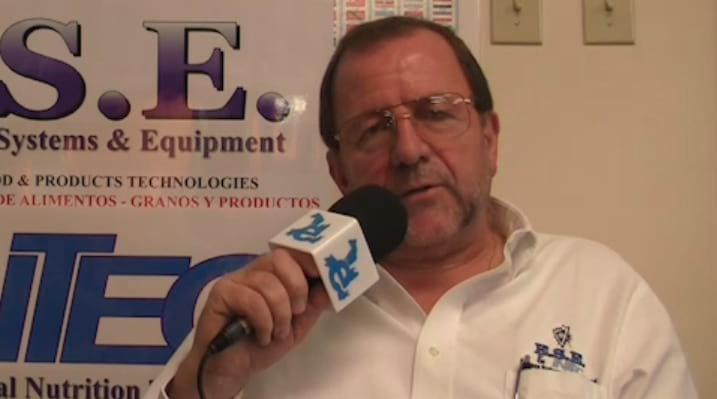pellet stability quality
Judging pellet stability as part of pellet quality
Feed is too expensive to waste, so pellet quality has an economic value. There are a number of excellent methods to objectively measure and record the quality of pellets during the manufacturing process. This is the first step toward correcting destructive conditions and improving quality.
Compound feed quality should be assessed by at least four different groups of characteristics: physiological characteristics, hygiene standards, environmental compatibility and technical characteristics.
These characteristics make product safety part of product quality [1]. Customers require high product quality – well to the fore are acceptable pellet stability, flowability or conveying behaviour in feeding systems and of course low costs.
The requirement of high pellet stability – at the same time meaning low parts of fines – is to be understood. Pellet stability is – besides shear strength and hardness – normally defined by the abrasion resistance. During handling (transport, storage, feeding) only a minimum of fines is allowed to be formed.
Mean pellet durability favours numerous disadvantages:
• feed losses by fines, because some animals refuse the intake of fines
• dusting potential, which is an important criterion with respect to the feeding period of dairy cattle as well as with respect to explosion risks
• flow properties and proportioning will be impaired by fines
• remainders in silos and bins will be increased by fines
• fines and dust are preferred nutrients and habitats for germs and micro organisms of any kind
• weak pellets will break in automatic feeding systems (e.g. tubular chain conveyors) and originate fines, the function of the feeding system may be restricted
• weak pellets will cause fines during unloading of bulk trucks and filling farm silos – depending on the length of hoses and number of couplings and the type of silo inlet [2].
For the feed miller the production of stable pellets is very important – not only with a view to possible customer complaints.
Abrasion arising during transport and storage within the plant has to be removed from the pellets and let back to the original batch. That means a reduced mass throughput and a higher specific energy input (kWh/t) and a highly difficult task along with numerous small batches according to customer’s desire and production may be a logistical problem in terms of avoiding cross contamination and ensuring traceability.
If the addition of sensitive additives should be carried out post pelleting (PPA), e.g. by means of continuous or discontinuous spraying, pellets have to be abrasion resistant. Even in case of scalping it had to be made sure that there would be no abrasion effect during fluid application. Because of the enlarged surface fines would favourably absorb fluids and additives and no homogeneous distribution would be achieved.
Finally, the fines are separated and the target concentration of the pellets is falling short, provided that the dosage was not super elevated. In this case there will be highly contaminated fines that could hardly be reused.
Factors affecting pellet stability
To all intents and purposes pellet stability is an important aspect of pellet quality.
How can it be influenced? From theory considerations and practical experience the effects of the influences on pellet durability are qualitatively known (Figure 1).
• Longer die channels increase the probability that binding will take place between the feed particles so that – supported by enhanced frictional forces – the pellet durability is adequately improved. The same effect is reached when using small bore-hole diameters. Normally the energy consumption will rise linearly, while the pellet stability tends towards a final value the longer the die holes are.
• A considerable influence on pellet stability takes the press-mass throughput. For fixed die dimensions and a given number of die holes, the load of each hole increases with higher throughput: the power intake rises while the pellet-stability decreases. This can be explained by the minor compaction of the thicker layer pressed into the holes at a time.
• Another important factor is the precompaction of the feedstuff before entering the die hole – caused by double-stage pelleting, the gap width between roller and die (automatic gap control) or the roller speed. The higher the speed (or the number of rollers), the smaller the material plug being pushed through the bore, the better the compaction inside the plug.
• Addition of pelleting aids can bind e.g. fatty contents by increasing the surface, this may contribute to a reduction of the pellet abrasion. But the effect of auxiliary agents depends to a high extend on feed mixture recipes.
• Finer grinding of the compound-feed components leads to larger specific surfaces and thus to more favourable conditions for the absorption of liquids and the effectiveness of the saturated steam and results in more firm pellets.
• Application of the saturated steam creates more favourable conditions for establishing bonds between feed particles improving pellet stability.
Increasing the amount of steam is limited because of crossing admissible moisture levels reducing the friction in front of and within the die channels.
• Feed ingredients influence the pellet stability in different ways. While – depending on moisture content and temperature – starch and protein may cause more stable pellets, fat as a lubricant reduces friction in the die holes and leads to weaker pellets. Increased fat contents lead to partial coating of the feed particles, which prevents the penetration of the steam and thus the development of binding agents – moisture bridges as well as the gelatinisation of starch.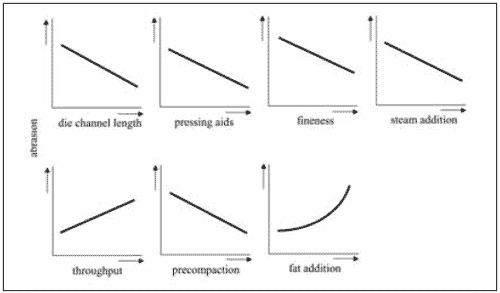
Figure 1:Factors affecting abrasion of pellets.
Possibilities to characterize pellet stability
There are various testing devices in the market using different kinds of stress to characterize the pellet stability during handling. For the feed compounder it is essential to receive quick information while the pelleting process is running. So if required, an intervention to correct the result e.g. by means of changing mass flow or steam input is possible. Testing time should be short, especially in case of small batches.
The industry offers on-line and off-line pellet testing systems as well. But nevertheless, only a few plants (in Germany) have installed automatically working online systems – maybe because of the high number of small batches to be produced – not allowing corrections within half an hour for example.
Those systems collect hot pellets leaving the pellet press, rapid-cool them and then test their durability in an air stream before discharging them. In most cases the systems can be programmed to accept sample pellets from more than one pellet press, providing pellets of almost same diameter are produced. Otherwise the tester has to be supplied with different sieve trays according to the pellet diameter to be tested. In order to ensure accepted pellet stability, the automatic pellet tester should be integrated with a computerized press control (Figure 2).
When testing pellets off-line, attention has to be paid to the time between sampling and testing, because only cooling cures pellets. To compare amounts and to receive representative results, it is absolutely necessary to practise standardized proceedings including:
• same device
• time of sampling after production
• ambient climate / relative humidity
• sample weight
• cleaning
• time of stressing
• sieve(s)
• wear (baffles, plates etc.)
Since various pellet testers make use of different stressing methods (mechanically, pneumatically, mech./pneum. in combination) outcomes can hardly be compared, in particular because wear of baffles and plates inside mechanically operated devices will influence test results.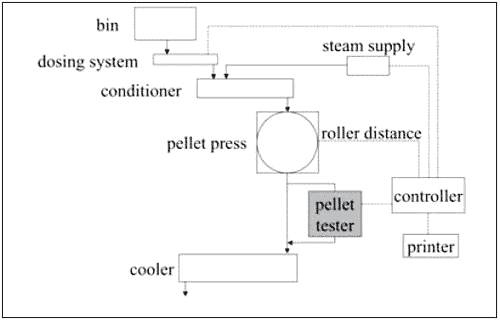
Figure 2:Automatic pellet-stability control.
Figure 3:Test device breaking behaviour (Kahl-Tester).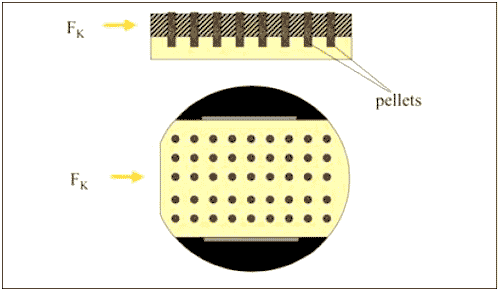
Figure 4:Test device shear strength.
Generally it has to be differentiated between single pellet testing and collective pellet testing. Single pellet testing for example is used to ascertain the breaking behaviour (Figure 3). To achieve results with high security, an extended number of pellets (n = 30-50) tested is neces-sary. To examine the shear strength is of more scientific character. For this purpose a number of pellets (n = 15-30, depending on diameter) is fed into a shear cell, which is divided into two parts (Figure 4).
While the lower part is fixed, the upper part is moved in parallel. The power needed is related to the cross-section of the pellet collective.
Abrasion tests need a sample size of 100 – 500 g per test. To cover the result, a test number of four is recommended.
The fines are measured, which are dissolved from the pellets during the test.
The mass is weighed and put in relation to the original sample mass:
• a = (mF /mI) • 100
• mF = mI – mP
with
a = abrasion [%]
mF = fines [g]
ml = initial weighing [g]
mP = pellet weight after test [g]
The most sensitive part of the pellet is the surface of the break resulting from cutting the pressed and extruded feedstuff into cylindrical pieces. The abrasion test stresses a high amount of pellets at a time, so a representative number is to be expected. Starting from a constant pellet mass, the number of pellets (= number of sensitive breaks) depends on the pellet size. Short pellets yield a higher number per mass than longer pellets. That means more possibilities to create abrasion and fines.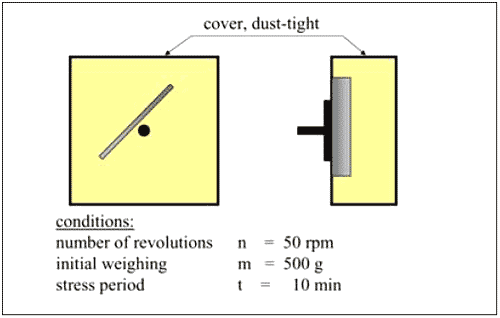
Figure 5: Abrasion test unit according to Pfost.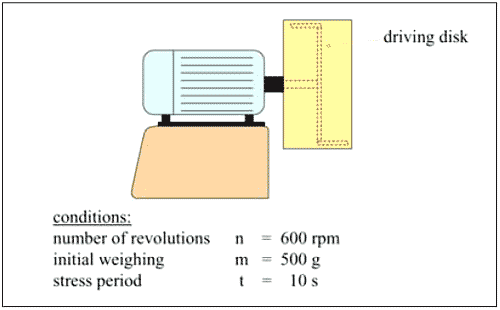
Figure 6:Quick pellet tester.
Consequently the abrasion index is combined with the pellet length – normally neglected in practical operation.
The sample to be tested has to be cleaned from dust; during sieving newly born dust has to be avoided – this fact is also important after testing, in case there is no automatic separating step within the test equipment. Then according to the test the sample mass is weighed and put into the device. After the test period fines and pellets are separated (either by hand or automatically) and put into relation.
An old-fashioned, but nevertheless well known and widely used method is the “Pfost Tester”, a device that stresses the pellets mechanically simulating mechanical transport by elevators, screwor chain-conveyors etc. (Figure 5). 500 g cleaned pellets are fed into a box that rotates 10 min at 50 rpm. A baffle plate inside forces the pellets to change their tumbling direction all the time. Commercial tester are fitted with up to four boxes, so within 15 min four results are available.
To remove the fines from the pellets, sieves according to the pellet diameter should be used (Table 1) [3].
Another method to test the pellets is the “Quick Tester” (Figure 6). Pellets fed into a cylindrical test unit are set in motion by a rotor and thus exposed to mechanical action. After the test, fines are again separated and related to the originally weighed material. Because of the intensive stress, the test period is only 10 – 12 s (adjustable).
The “Holmen Tester” simulates the stress to which pellets are exposed when conveyed pneumatically through tubes or when unloaded from bulk trucks. It involves circulation of a pellet sample (100 g) through a pipe system, the transporting air stream being produced by a fan (Figure 7). At the beginning of the test, the material is fed into the cycle by a solenoid valve. The test period can be set at 0.5 – 2.0 min. Subsequently the sample is automatically passed on to a sieve where fines are immediately separated.
Weighing the sieve oversize after the test allows the percentage of abrasion produced under the specified test conditions to be determined. The possibility to interfere with the testing Another combination of mechanical and pneumatical stress simulates the “Ligno Tester”. A sample of 100 g is tested within a closed chamber. Pellets are bounced against a perforated surface (like a sieve) with high velocity of pressure air, controlled by means of an integrated monometer. The openings of the sieve are constant for all pellet diameters.
One test period takes 30 s (Figure 8). Subsequently the pellets are emptied into a scale to determine the remaining mass or the created fines respectively.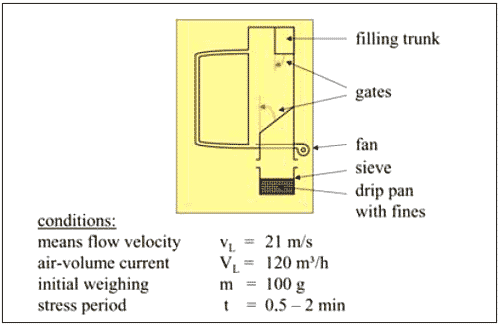
Figure 7:Impact test according to Holmen 8.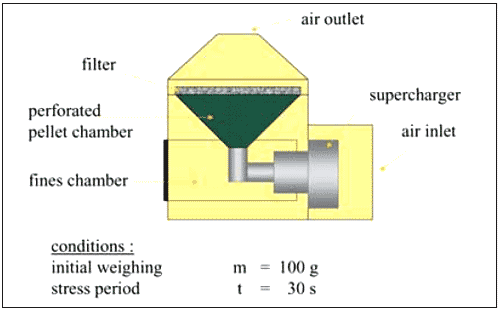
Figure 8:Ligno pellet tester.
Table 1:Wire netting for test sieves according to pellet diameter.
Because of small batches to be produced, a quick information concerning the pellet stability as a main aspect of pellet quality is requested. In consequence there is a great demand for pellet testers which provide results in a few seconds like Quick or Ligno Tester. Nevertheless, mentioned limitations should be kept in mind. As lined out, pellet testers in the market are simulating different types of stress pellets may be exposed to. The way stress is applied, varies. This means that it is nearly impossible to compare single durability data taken or received from different equipment. Pellet durability information therefore should include detailed specifications of the testing method used anyway.
Literature
Heidenreich, E. Consumer protection as a toppriority and opportunity for the feed industry Feed Compounder 21 (2001) 9 pp. 24-27
Robohm, K.-F. Qualitätssicherung von Mischfutterpellets durch Bestimmung physikalischer Stoffeigenschaften (Quality assurance of compound- feed pellets by determining physical material properties) Die Mühle + Mischfuttertechnik 124 (1987) 15, pp. 191-197
Friedrich, W. Bestimmung der Abriebkennzahl zur Charakterisierung der Pelletfestigkeit (Determination of the abrasion index for characterising the pellet stability) Mühlen- und Mischfutter- Jahrbuch 1978/79 Verlag Moritz Schäfer, Detmold
Source references of pellet testers are available from the author.
Author: Rainer Löwe
Research Institute of Feed Technology of IFF Braunschweig - Thune, Germany.
 | The previous article is a special collaboration from AFMA South Africa |









